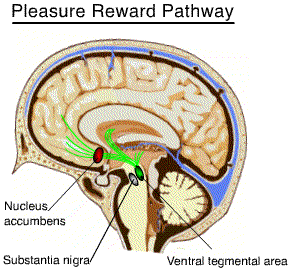
Physiology of Drug Abuse
Research into the causes and mechanisms of drug abuse have led scientists to conclude that there are distinct areas of the brain involved in the response to psychostimulant substances. Collectively, these areas are called the Pleasure Reward Pathway (PRP).
The PRP includes the dopaminergic pathway from the ventral tegmental area (VTA) to the nucleus accumbens (NA) and extending to the prefrontal cortex. Dopaminergic pathways are activated by the neurotransmitter, dopamine.

Most of the experimental data is derived from animal experimentation during which electrodes were placed into the PRP of rats and monkeys. The animals were allowed to stimulate their PRP by pressing a switch bar. Bar pressing soon occupied most of the animal's time. Many animals were seen to forego food and water in preference to autostimulation. The autostimulation in many instances continued to exhaustion. Some monkeys were clocked at 17,000 bar presses per hour.A number of PRP autostimulation experiments have been done on humans. Many of the participants described a "quiet relaxed feeling" or "relief of tension." However, those participants with the highest rates of autostimulation were unable to explain why they continued to bar press. From these and other experiments, scientists theorize that the PRP functions as a "motivator" through which the organism receives a reward when VTA and NA are stimulated. The "motivator" function is important to organisms which must actively engage their environment inorder to find new sources of food, shelter, mates etc.
The primary effect of stimulation of the PRP is an increased synaptic concentration of the neurotransmitter dopamine. Many commonly abused drugs increase the synaptic concentration of dopamine within the PRP. Of these, opiates, cocaine, amphetamine, ethyl alcohol and nicotine have been most studied. Each of theses drugs work differently but all have the effect of increasing the amount of dopamine available for binding with dopamine receptors in the NA.
Instant Feedback:
Increased dopamine within the synaptic gap can overwhelm the system's ability to clear the excess neurotransmitter. This can lead to the depolarization of neurons unassociated with any stimulation arising in the VTA. Schizophrenia is believed to have a similar component. As an aside, superstitions may arise in a similar fashion; where the individual forms a belief based upon an uncorrelated reward.
Animal studies also indicate that the PRP is stimulated when the subject encounters a non threatening novel experience. It was also found that novelty seeking behavior could be blunted by the administration of dopamine antagonists. This information has implications regarding learning, thrill seeking and drug abuse. It is currently not possible to determine if one individual is organically more prone to drug abuse than the next. However, elucidation of the human genome may, in future, allow medicine to select individuals who are at risk. Once identified it could be possible to develop medications or create environments that fulfill the individual's need for stimulation, eliminating the need to self medicate.
This illustration represents chaotic depolarization resulting from excess synaptic neurotransmitter.
Compare
this with the orderly activity of normal neurotransmission.